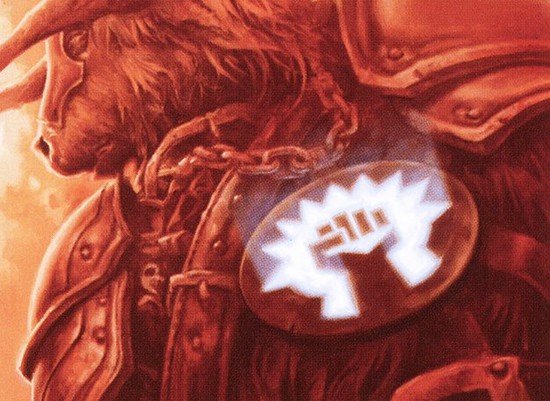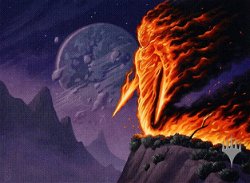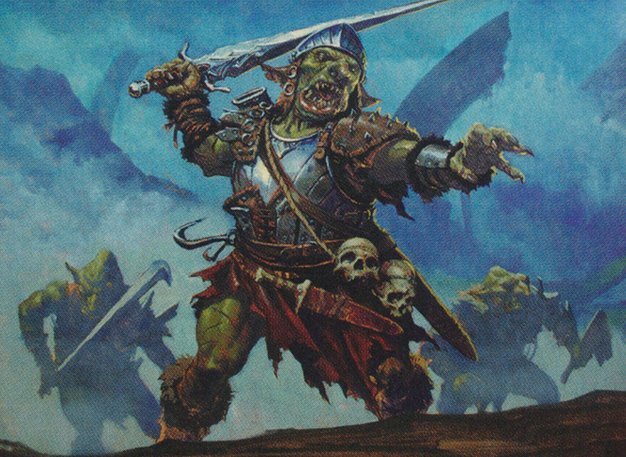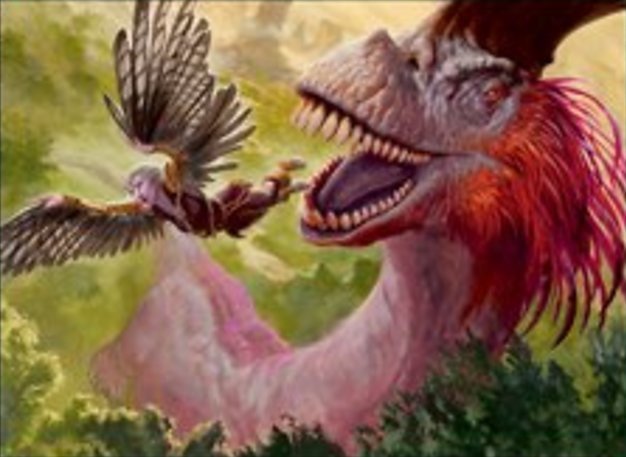Introduction
I promised that if I won the Pioneer Royale finals, I would feel qualified enough to make a Deck Guide of the deck I played with the most in recent months, the main list I piloted in Pioneer tournaments and the deck I have been dedicated to within the format since I started playing Pioneer Royale events. You can find more information about the event here.
So today I would like to take you on that journey, where I try to pass on to my readers the knowledge and ideas that I usually have with an archetype that is almost as classic in Magic as the game itself, with its first variants appearing in 1996.
Ad
Over time, the creatures got better, spells became more efficient, new concepts of game strategy and deckbuilding were created until we reach this moment of Magic in which we live today.
Sligh, Burn, Red Deck Wins, among other aggressive red decks can be considered the predecessors of the original concept of Tempo in Magic: The Gathering.
Before the concept became the basis of an archetype of blue-based decks and had a life of its own, Tempo was a term used literally, derived from musicology, where it represents the duration of each unit of the measure and the movement with which it must be performed an excerpt from a song.
In Magic, Tempo meant dictating the pace of the game, setting the clock and making the opponent play at your own pace, and just as some musicians have great difficulty keeping track of other musicians or certain songs, the Red-Based Decks strategy is based on making the opponent fail to keep up with the pace and lose the game.
After all, playing a game of Magic in some ways is a lot like playing a song, but that's a story for another article.
In summary: The original concept of Tempo, before becoming its own archetype, means the number of turns you need to take win the game and make your opponent fail on keep up with it.
Burn in Pioneer
There are two Burn variants on Pioneer:
The Mono Red Version that bets on a more balanced manabase that allows the use of Ramunap Ruins, in addition to the inclusion of the Standard staple, Bonecrusher Giant in the list due to the absence of Lurrus, and uses cards like Goblin Chainwhirler and Chandra, Torch of Defiance on the Sideboard.
And the list that we’ll cover today: Boros Burn, which uses an extremely low curve to play "under" the main decks of the format while managing to keep its breath in the late game thanks to Lurrus of the Dream-Den, which allows you to reuse your creatures and demands an immediate response from the opponent at a moment in the game when, normally, he has already spent all his resources dealing with other threats.
So let's get down to the list:
This is the standard list, this is what 90% of Boros Burn decks look like and will be played on Pioneer, with some numbers occasionally fluctuating between Sideboard slots. So it will be with this list that I will work on this Deck Guide.
Before entering maindeck, I think it's important to talk about Companion:

Lurrus was the card that led Boros Burn to its birth in Pioneer, the ability to reuse threats every turn as a source of card advantage coupled with a fast clock that needs constant interaction and responses made the deck become one of the main Tier 1 of the format along with other companion decks like Orzhov Auras and UW Ensoul.
With the Companion mechanics errata, Lurrus decks suffered considerable damage, but continued to present themselves in Metagame as a force present in the form of Boros Burn and Orzhov Auras.
Currently, Lurrus of the Dream-Den serves as the deck's mana sink, that card you usually get when you get to the late game and have little interaction, or when you can establish a good strategy at the table if you can put it into play. There are many games where you simply won't need it because the game is over before you run out of breath or have enough mana to pull you out of the sideboard and play another spell, but it makes an essential difference when you need it.
Ad
Thus, one of the most important tips I can give you regarding this deck is: Don't forget Lurrus, remember that you can search for him whenever there is mana left for that. It is very common to forget him in the heat of the moment, especially the first few times piloting the deck.
Now, regarding the Maindeck:

These are your one-drops, it is preferable to start the game with one of them in turn one. Soul-Scar Mage and Monastery Swiftspear basically have the same function of being low-cost threats that grow by the deck doing what it already does naturally and become a clock that the opponent needs to respond to as soon as possible. They are also cards that have great interactions with combat tricks that can lead the opponent to under-optimized blocking options.
It’s worth remembering that Soul-Scar Mage’s ability causes any damage spell to become -1 / -1 counters on the opponent’s creatures, which can be an important interaction for dealing with larger creatures or it even invalidates them on some occasions.
Ghitu Lavarunner is the worst one-drop on the deck, but it is a creature that has an immediate impact on the table in mid-game, where it becomes a slightly better version of Goblin Guide, and can mess up the math for the opponent on whether attack with his creatures or not.
Finally, we also have Zurgo Bellstriker, which enters the flex-slot of the deck and is another creature with a CMC 1 in a 2/2 body, with the advantage of being able to be used with Dash to protect itself from sweepers.

The deck's 2-drops are cards that have an immediate impact on the board.
Viashino Pyromancer is a 2/1 body that comes with a Shock that can only be targeted at players or planeswalkers attached to it, potentially reaching 4 or even 6 damage done to the opponent until the opponent resolves spend resources dealing with a measly 2/1.
Eidolon of the Great Revel has the function of being the punitive card for the opponent when you are ahead in the game. Unlike the other formats where it is commonly the best play of Turn 2, Eidolon of the Great Revel is better at Pioneer when you have already used your initial resources and are moving to mid-game.
There are exceptions to this rule. For example, if you are facing combos or if you are facing a Control, it is preferable to make Eidolon as soon as possible to serve as a card that will severely punish for any play that the opponent tries to make to answer it or to give more range. .
It is very important to measure the value that Eidolon of the Great Revel can have when it comes into play when you have it in hand. If you still have other things to play, in most games it is preferable to wait to play it at the right time where your life is superior to your opponent's by a significant margin.

Ad
Your burn spells.
Wild Slash is basically a Shock that, on very rare occasions, can serve to disrupt damage prevention by opponents if there is any. But most of the time it is just a low cost interaction against other aggro decks and another low cost Prowess trigger for your creatures.
Lightning Strike and Wizard's Lightning are cards that you should preferably target your opponent, unless there is a creature that needs to be answered at the board. Both are the cards that go into the famous "math of 3" that Burn uses in most formats.
It is worth mentioning that Soul-Scar Mage, Viashino Pyromancer and Ghitu Lavarunner are Wizards and consequently transform Wizard's Lightning into Lightning Bolt by reducing their cost. Take this into account when sequencing your creatures.
Boros Charm is the deck's best damage spell as it deals 4 damage for 2 mana, but it also has two other important functions, since Double Strike given to any creature can make it survive the combat, while the ability to make your permanents indestructible can serve to protect your threats from removals or a sweeper like Supreme Verdict.
Usually, Boros Charm is the last spell I want to use blindly in the opponent's life because it has the most range, being best used to end the game due to its flexibility.

Light Up the Stage is our engine to have more range in games, being commonly a card that, for one mana, allows you to "draw" two cards. There are many situations where Light Up the Stage saves your game by finding the land that you lack or the interaction or threat that was missing to end the game.
On the other hand, the card is a terrible topdeck, perhaps the worst outside the lands because you often need more damage cards and don't have enough mana to cast Light up the Stage and one of the revealed cards on the same turn, giving space for the opponent to then plan according to what is revealed.
Although considered essential for Burn, it is one of the cards that most often comes out post-sideboard.

Your red and white sources that comes untapped. Some lists use Needleverge Pathway as another way to access white, but the fact that you need to choose the color and there are times when Burn needs a lot of red mana, in addition to including Chained to the Rocks on the sideboard makes me keep some distance from the card and choose this base of twelve dual lands.
Sideboard
The traditional Boros Burn Sideboard can be summed up in three types: Cards that enter against creature decks, cards that enter against control or midrange decks and cards that enter against graveyard decks.
However, these cards mix up and are usually present in the most diverse matchups.

It is the closest to Path to Exile we have on Pioneer. It is usually the most sided-in card in games as it serves against a significant range of decks and is your best response against large threats that demand immediate response such as Uro, Titan of Nature's Wrath, Omnath, Locus of Creation, Niv-Mizzet Reborn, among others.
Ad

More removal because the deck usually has difficulties against decks that have a significant number of creatures. It usually goes against most aggro decks and it is worth remembering that the controller of the creature affected by Searing Blood will be dealt damage even if the creature was not killed by the spell, but by another effect such as combat damage or other removal.

The best card that came out for the archetype recently. Roiling Vortex is your safety valve for dealing with lifegain as well as adding yet another way to reach with a threat that is not easily answered by conventional cards.
Usually it goes against decks where the lifegain is relevant and / or matches against decks that usually last until the late game, like control decks or most midranges.

The Ikoria common started to gain slots in Burn's sideboard according to how the mirror and matchup against Auras became more recurrent. The card has multiple uses between removing problematic enchantments like All That Glitters, taking a few extra turns when gaining 4 life, or serving as a good combat trick when adding a + 1 / + 1 counter.

Last but not least, the graveyard hate.
Soul-Guide Lantern tends to get into more matchups than it initially looks, since in addition to handling decks like All Spells and Soulflayer well, the deck plays a significant part in being a disruptive element against Uro, Titan of Nature's Wrath and also serves as a card advantage engine alongside Lurrus of the Dream-Den, which can be recast every turn to draw a card.
Why You Should Play this Deck
Burn acts as Pioneer's "Fun Police".
This is the deck that punishes the opponent for trying to do too much, keeps the value decks in check by establishing a clock that they need to respect and that the other Aggro decks need to keep up with.
In short, Burn is the deck that dictates the speed which other decks of the format need to play in order not to lose the game.
It is also the deck that most punishes and is relatively less punished by the variance factor: most of your cards potentially do the same thing in different ways, causing damage to your opponent.
The other decks, on the other hand, usually need multiple different pieces of interaction or colors of mana that end up slowing them down and reducing consistency, making them easy prey for Burn if they come to get mana screwed, draw the wrong half of the deck, spend too much time doing a setup or interacting badly.
Different from what many players usually think, Burn is an extremely interactive deck that rewards players for having a good knowledge of the deck and the format.
Having a sense of when and how to sequence your spells, what is the best opening to get the most out of every moment of the game and where it is most important to target your spells at the player or his permanent is a job of constant knowledge of the Metagame and of the behavior pattern of the format decks.
Ad
Burn, therefore, despite looking like a linear deck with a simple game plan, requires a lot of knowledge of the format to be played with mastery.
The deck also has some games where there is a "free-win" button, which is when everything you play is perfectly sequenced and you can take the game with ease before the opponent can stabilize.
Another relevant factor about the deck is that Burn games tend to be fast and less tiring games than the games when you're playing the Midrange and Control decks of the format, giving you more time to rest up and clean your mind during matches, thus being psychologically better prepared for the next round.
Finally, it is a cheap deck to rent, costing approximately 100 tix, which means that, for an average of 3 tix per week (according to Cardhoarder values), you can rent the deck and play as much as you want with it.
Why You Should Not Play this Deck
The main reason for not playing Burn is its linear game plan: All cards have the same objective of taking the opponent's life to zero as soon as possible. Consequently, the deck lacks flexibility or alternative ways of interacting in the game when the opponent is well prepared to deal with the deck.
Speaking of preparation, since it is the "Fun Police" format, all Pioneer decks today must have a plan to play against Burn, which means that the deck is highly targeted within the Metagame and Post-Sideboard games are usually more difficult, especially if the opponent's sideboard comes at the right time.
Finally, Burn is a punitive deck. That one life you didn't do damage at your opponent six turns ago can easily become the reason you lose the game, so it is very important to know how to sequence your spells correctly and there is no "map" of how to play Burn because all your plays have very different values depending on the circumstance of the match and each opportunity within the game, therefore being a relatively difficult deck to master.
In the next article, I will be making a detailed Sideboard Guide from each matchup with Boros Burn, as well as a brief analysis of the list I used in the finals of the Pioneer Royale!









— Kommentare0
Sei der erste der kommentiert